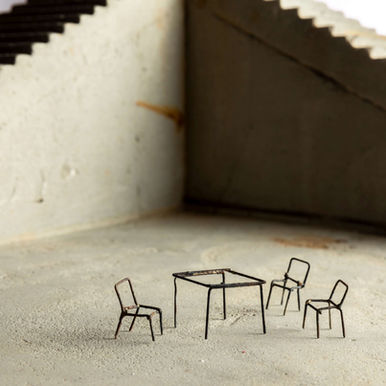
Spatial Monologues:
Art; If we say that it is a way of taking a certain distance from the outside world, we begin to talk about what the artist puts between himself and the earth. After a certain point, this conversation starts to cover us/the audience as well. Because art comes in the company of the soul, body and mind of the person who produces it, and it multiplies among other bodies with various meanings. The meaning, which gets closer in some places and which sometimes is thrown away to other places, always needs a new translation, starting from the source with a theme born from the artist. In other words, what is going on between the artist and us is alienation. An alienation that starts between the artist and the earth and continues in us, which needs a new translation each time. Distance, on the other hand, remains existing as the language of this translation between the beginning and the destination.
Can Özal's space-sculptures call for just such a translation where the artist intersects the individual with the public. These other things, which hide the possibility of the artist's being a shelter, a private, a sacred place, are at the same time a representation of the distance between the familiar and the new, with their new state evoking a real place. A pool, a park, a house, a wall, a tower, a temple… Özal's sculptures, which transform as they resemble each other, are built between the familiar and the known. It can be assumed that they were made for those who reach the sacred, who are concealed with privacy, who are covered with fear, and hide with suspicion. The mind may have the feeling that I saw something similar somewhere. When looking at a new object, he may persistently try to envision that structure in the real world. However, space-sculptures are what Özal constructs by means of his body, using less real and more dream states, and what we know collides with what we don't know. What we see becomes what we do not see.
While Can Özal's sculptures touch on an architectural structure and the time connected to it, they point to arrival and effort with the metaphor of the staircase that exists in most of them. Higher, better, more beautiful, more holy, more sublime… Were Özal's steps built for an uncanny and uncertain journey, or did each adventure, with the intention of progress, mix the steps on which he walked with its own tragedy? These sculptures, showing an uncertain address and claiming an undefined space, combine the space they are in with the space they carry, are accompanied by these questions.
At the same time, Can Özal's sculptures of space are monuments which are dedicated to emptiness, intertwined inside and outside, bearing the absence and presence of truth at the same time. They always bring to mind the question of where this place is, and create a self-confident humming void that embraces the chaos by returning it to the present with the pedestal on which they are placed, which gives the feeling of devotion to the sublime with their majesty. As the French poet, writer and painter Henri Michaux mentioned about the existence of space in his prose poem "L'espace aux ombres" (The Void of Shadows): "Space, but you cannot conceive it, this terrible inside - outside, this is the true place. Devastated by the punishment, now it was just a noise, and what a noise…"1
These sculptures, with their rusty surfaces and partially eroded forms, become a “place” between fiction and reality; Together with the cyclical rhythm and common horizon line between perception and time, they create a dynamic atmosphere with noisy space. Now the past and the future are released simultaneously. While recording the space, we see a place that is interlocked between the material and the plan by constructing the time. Moreover, these sculptures, which do not ignore time, are without people, without shadows, without a homeland; in a dream, a novel or a movie, perhaps anywhere on earth, when we encounter them, they create a vast unnatural space between the earth and bodies.
Can Özal has built nowhere in the future: by placing the fear of abandonment and the doubt of the unknown between inside and outside. The indicator is the place, the indicated is fear; these masses, in which the voices of the rulers echo and the vitality are swept away, have just become lonely there. As Rene Descartes wrote in his Meditations; “…today, having provided myself with a safe place of rest in quiet solitude, I undertake, with complete seriousness and freedom, the total destruction of all my old convictions.”2
Can Özal rebuilds everything he knows on his own workbench, which turns into ruins. Is this little giant place that has emerged suitable for life? Is it a destination? Or is it an abandoned place? The questions we have multiplied about the destination make us think about going and connect us to the French thinker Jean-Luc Nancy's text To Go/Departure: “To go is always leaving a part of the familiar; for a part, for a place, for a part of life that is foreign, unfamiliar, and totally unknown to us beforehand.”3 So, while Can Özal builds a place that has individual familiarity with the departure/arrival place; insists on these abandoned/gone places. Because to go is to talk to yourself. To arrive is to carry yourself.
1 Henri Michaux, Nouvelles de L'étranger, ed. Mercure de France, 1952, p.91. Quoted by: Gaston Bachelard, “The Poetics of Space”, Ithaki Publications, 2018, p.260.
2 Rene Descartes, Meditations, trans. İsmet Birkan, Bilgesu Publishing, Ankara, 2007, p.15.
3 Jean-Luc Nancy, To Go/On the Road, trans. Murat Erşen, Monokl Publications, Istanbul, 2012, p.4.
Nazlı Pektaş
Translated by: Pelin Altınalmaz























